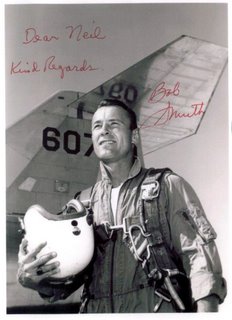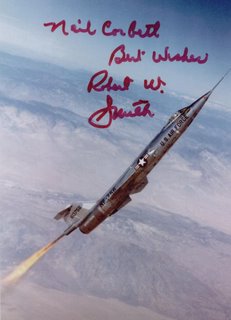Lt Col Robert W.Smith 1928-2010



The seeds of flight were sown when he was about 10 years old by Bob’s uncle, who was a pioneer Naval Aviator. Uncle George Luckett was the 18th pilot of the United States Navy. Those seeds germinated with the news of the competition between the Air Force giant B-36 bomber and the Navy flying boats, during Bob’s second year of college and he enlisted as an Air Force Aviation Cadet, for pilot training.
He trained for a year, first in the advanced trainer of WW II, propeller driven T-6 Texan, where his desire to fly the big bombers was pushed far in the background by the excitement of aerobatics and ‘dog-fighting’, so he earned selection to advanced training in one of the first classes for jet pilots flying the first truly operational jet fighter, the F-80A, Shooting Star. He graduated the day of the beginning of the Korean War.
A year of training in the 1st Fighter Wing, 27th squadron, America’s first in WW I, was preparing him for a combat tour in the premier jet fighter, F-86 Sabrejet and in the process opened the way to learn formation acrobatics, like those of the famed flying teams. His flight commander and two best buddies became that informal, but proficient team. A fortunate circumstance led to his hearing about two of the finest pilots of their day, Chuck Yeager who had just overcome the boundary of supersonic flight and Kenny Chandler, both of whom he would subsequently serve with. It happened less than three months after getting his wings, when Bob visited the RCA Movie Studio with the stars of the movie “Test Pilot”, John Wayne and Janet Leigh, and witnessed a film of those two pilots flying an incredible and dangerous stunt that he vowed to duplicate, and soon did. His check-out flight in the P-51 Mustang of War II fame closed out his training with a dreaded flat spin, from which recovery could not be expected, necessitating bail out if unsuccessful, he fell out of control for nearly 20,000 feet in that unusual learning experience shared by few living pilots.
Bob shipped to the 4th Fighter Wing in Korea, where he flew air-to-air combat in opposition to the Mig-15 jets flown by Russian and Chinese pilots. He was soon joined in the 335th squadron by those same two buddies, John Honaker and Billy Dobbs. Together they amassed a fine combat victory record, however only Bob would enjoy the results for very long as both died in aircraft disasters within a year. Bob’s first aerial combat encounter made him the wingman of the world’s third Jet Ace, but then pitted him against four Migs with their cannon working effectively in an all-out effort to destroy his wounded airplane, alone and over 200 miles from home base. His subsequent fights in the span of 100 missions resulted in successes and failures, before returning home to a squadron in the Air Defense Command, where he joined a team in a competition of aerial gunnery for the national title. That team was led by his commander in Korea and jet Ace ‘Bones’ Marshall. It was during that tour that he made a decision to finish college and get a degree in aeronautical engineering in hopes of becoming an Air Force Test Pilot.
Two years later, as a new engineer, he entered the Test Pilot School resulting in assignment to test flying at the Air Proving Ground Command. There he began to add to the more than 50 different types of military airplanes he would fly. That tour of duty included some unusual flying events and close calls during some of the greatest air demonstrations ever presented to the public. He details his challenges, his successes and his goofs, some of which were in the extreme. Among them was his opportunity to fly solo in the formation of the Air Force Thunderbird Team and be invited to join them as one of the team members. That honor was squelched when a powerful officer, decided that Smith’s education and experience would lend more in developing the growing ballistic missile force of the U.S. The ensuing and unhappy times had a redeeming opportunity and that was to be a significant part of the celebration of his favorite Air Force hero. The result was being part of a national TV show on NBC, ‘The Life of Jimmie Doolittle’, with the great man, himself.
That introduction, and a personal recommendation by General Jimmie led to Smith’s assignment to the new Aerospace Research Pilots School for astronaut training and his selection by the Air Force as one of nine candidates for the Gemini/Apollo astronauts. It also returned him to flight test at the Air Force’s premier test site, Edwards California. There he would become the Air Force test pilot for the NF-104A, AeroSpace Trainer, an effort to train future astronauts in actual space flight in a reusable Jet-Rocket craft, with normal take-off and landing. It was during that testing that he flew higher than anyone ever had under those conditions and set an altitude record for flight with ground takeoff that would hold to this day, had it been officially sanctioned in Paris. That program would ultimately falter, as the result of an accident in one of the three aircraft, when Col. Chuck Yeager lost control and crashed, seriously injured.
That event led to Bob’s conflicts with the President of Yeager’s Accident Board and to reassignment and ultimately to Lt. Colonel Smith’s choice for early retirement from the Air Force, ASAP.
He departed Edwards for Headquarters of Systems Command, those who are responsible for development of Air Force weapons. Having flown chase for the first flight of the experimental XB-70 bomber that flew three times the speed of sound, he found himself on the collateral board of inquiry and punishment resulting from a midair collision between that bomber and a fighter flown by Joe Walker the NASA pilot who stills holds the altitude record above 350,000 feet for air-launched flight in the X-15. Both Joe and Major Carl Cross, one of Bob’s test comrades, were killed. That tour was cut in half , to his delight, when Lt. Col. Smith volunteered for combat in Vietnam. Based on the letters and experiences of his best friend who was flying there, Bob chose the most challenging and exciting of all tours, that of the F-105 Thunderchiefs (Thuds to their pilots), which were flying all of the long range dive-bomb attacks to the heart of North Vietnam; Hanoi and surroundings. He considers that job as a commander the epitome of his Air Force career.


<< Home